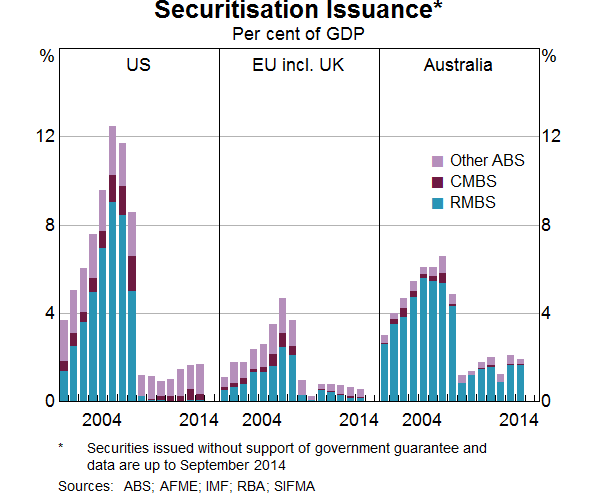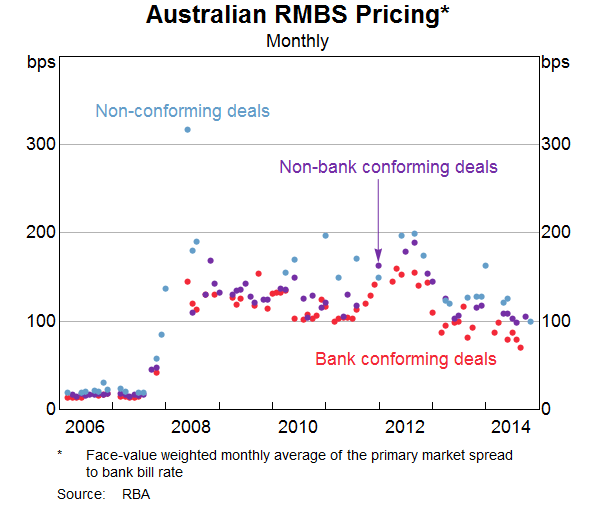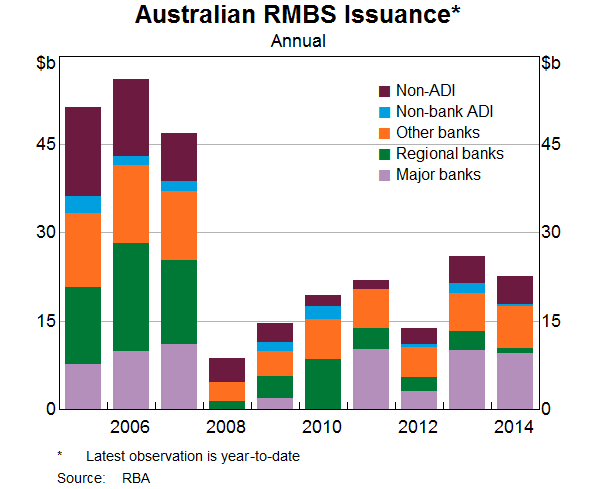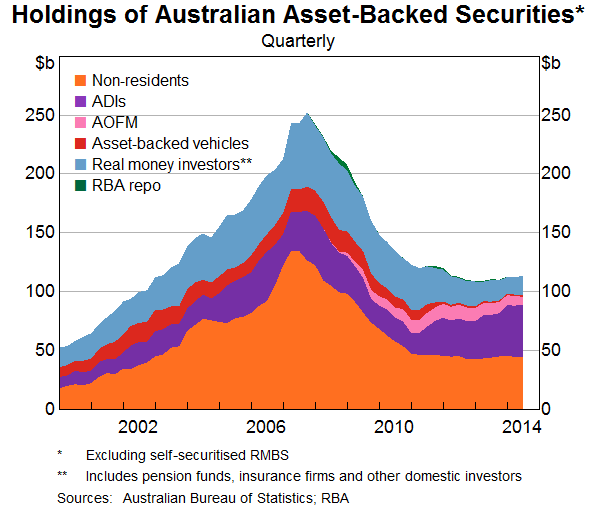Speech The Securitisation Market
Introduction
Thank you for giving me the opportunity to speak here today. My remarks are in two parts. The first part scans recent developments in the securitisation market. In the second part, I will discuss the role of asset-backed securities (ABS) in the Bank's market operations and how we manage the risks around these securities.
Recent Developments
Let's start with the global backdrop. While conditions in global financial markets have improved since the depths of the global financial crisis, the market for asset-backed securities has notably lagged this improvement.[1]
Issuance of private-label asset-backed securities in the US is currently equivalent to around 1½ per cent of GDP, compared with an average of around 8 per cent in the first half of the 2000s (Graph 1). Issuance of private-label residential mortgage-backed securities (RMBS) has been virtually non-existent since 2008. In contrast, issuance of auto loan-backed securities is nearing its pre-crisis level. Issuance of securities backed by student-loans and credit card receivables is also growing, though it remains well below its pre-crisis peak.

Activity in the European securitisation market remains very subdued, with annual issuance placed with investors relative to the size of the economy declining for the fourth year in a row. While the challenging economic conditions on the continent have contributed to this, European authorities have identified a number of other impediments and are developing proposals to address them.[2] In September the European Central Bank (ECB) announced that it will implement an asset-backed securities purchase program aimed at expanding the ECB's balance sheet. While this program is not explicitly targeted at reviving the European ABS market, the ECB expects the programme to stimulate ABS issuance.
In comparison with its overseas counterparts, the Australian securitisation market, which remains predominantly an RMBS market, has experienced a strong recovery over the past couple of years, albeit not to pre global financial crisis levels. Issuance started to pick up in late 2012, reached a post-crisis high in 2013, and has remained high since then.
This mainly reflects the strong performance of Australian residential mortgages and the high quality of the collateral pools which are primarily fully documented prime mortgages. While delinquency rates on Australian prime residential mortgages increased after 2007, this increase was a lot less severe than in most other developed economies (Graph 2). Indeed, serious delinquencies in Australia, those of 90 days or longer, remained below 1 per cent and have declined since 2011 to around 0.5 per cent currently. Mortgage prepayment rates, which affect the timing of the payments to the RMBS notes, have also been relatively stable in Australia, resulting in subdued prepayment and extension risk for RMBS investors.

Issuance margins on RMBS continued to tighten throughout this year across all categories of issuers (Graph 3). Banks have been able to place their latest AAA-rated tranches in the market at weighted average spreads of 80 basis points – the lowest level since late 2007. Spreads on the AAA-rated tranches of non-bank issued RMBS have also declined, to around 100 basis points. Investor demand has extended across the range of tranches, with a significant pick-up reported in demand for mezzanine notes. As a result, a number of issuers have priced their mezzanine notes at some of the tightest spreads since 2007.

Similar to last year, RMBS issuance this year has mainly originated from the major banks (Graph 4). Indeed, issuance by the major banks is on par with their issuance prior to the global financial crisis. Issuance by other banks has also been robust this year, although it is still well below pre-crisis levels when these issuers accounted for around 40 per cent of the market.[3]

Mortgage originators have been active this year, although their issuance has predominantly been of prime RMBS. Mortgage originators have issued only $1.6 billion of non-conforming RMBS in 5 transactions so far this year. The number of mortgage originators active in the market in the past two years has increased relative to the period from 2009 to 2012.
They are an important presence in the market. In the period preceding the global financial crisis, mortgage originators took advantage of innovations in the packaging and pricing of risk. In doing so, they were able to undercut bank mortgage rates. The banks responded and spreads on mortgages declined markedly. While a number of large mortgage originators have exited the market, the presence of mortgage originators promotes competition in the mortgage market.
Issuance of asset-backed securities other than RMBS has generally been in line this year with previous years. Issuance of commercial mortgage-backed securities (CMBS) and other ABS this year has been around $5 billion, compared with an average of about $6 billion over the three preceding years.
The investor base in Australian ABS has continued to evolve (Graph 5). The stock of RMBS held by non-residents has been relatively steady since late 2010 suggesting that non-residents have been net buyers of Australian ABS. The strong performance of Australian RMBS and lack of issuance elsewhere may have been an important driver behind the participation of foreign investors. There has been a pick-up in RMBS holdings by Authorised deposit-taking institutions (ADIs) – they now hold just under 40 per cent of marketed ABS outstanding – with the major banks accounting for much of the increase.

Holdings of ABS by real money domestic investors have gradually declined, to the point where these investors, in aggregate, now hold less than a quarter of what they held four years ago. The longer-term sustainability of the Australian securitisation market may well depend on increasing participation in the market by domestic real money investors.
One of the key structuring developments since mid 2007 has been the increase in credit subordination provided to the senior AAA-rated notes. This primarily reflects decreased reliance by the major banks on lenders mortgage insurance (LMI) support in their RMBS. This trend has been driven by investor preference for detaching the AAA-rating on the senior notes from the ratings of the LMI provider.
The increased subordination in the major banks' RMBS has been to a level in excess of that required to achieve a AAA-rating without LMI support. This mitigates the downgrade risk owing to changes in ratings criteria. In contrast, other categories of RMBS issuers have continued to use LMI to support their structures, allowing them to achieve AAA-ratings on a larger share of their deals.
ABS and Market Operations
As you will be aware, ABS can be used as collateral with the Reserve Bank in our open market operations and liquidity facilities. As at June, the Bank held about $25 billion of these assets under repo as part of our liquidity management operations (Table 1).
| June 2012 | June 2013 | June 2014 | ||||
|---|---|---|---|---|---|---|
| $ billion | Per cent of total |
$ billion | Per cent of total |
$ billion | Per cent of total |
|
| CGS | 9 | 35 | 16 | 42 | 18 | 25 |
| Semis | 9 | 35 | 9 | 30 | 16 | 22 |
| Supras | 1 | 2 | 1 | 4 | 3 | 5 |
| ADI issued | 6 | 23 | 8 | 19 | 9 | 12 |
| RMBS | 1 | 3 | 1 | 4 | 25 | 35 |
| Other(a) | 0 | 1 | 0 | 1 | 1 | 1 |
| Total | 24 | 100 | 35 | 100 | 71 | 100 |
|
(a) Includes government guaranteed securities Source: RBA |
||||||
Our current holdings are a function of our liquidity operations, in particular the expansion of the facilities we offered as part of the move to same day settlement of direct entry payments in November 2013. This resulted in a larger volume of repos being entered into by the Bank on a regular basis. In fact, the Bank's balance sheet expanded by about $20 billion – on the liability side of the Bank's balance sheet, exchange settlement account balances rose, while on the assets side, the Bank took self-securitised mortgage backed securities under repo. The Bank's use of self-securitised assets for this purpose reflects a number of factors, most notably a shortage of marketable collateral assets.
The Bank manages the risk of its ABS and other collateral to a very high standard, as ultimately the risk is borne by the taxpayer. There are three main elements to this: the quality of the collateral; a margin regime for managing risk; and accurate valuation.
The quality of the collateral
ABS are the only securities that the Bank accepts as collateral that are directly backed by real assets. Only the highest credit quality ABS, those with a AAA, or equivalent, rating, are eligible collateral with the Bank. Most of the other forms of eligible collateral are unsecured claims on highly rated issuers. Structured through bankruptcy remote vehicles, the credit quality of ABS reflects the quality of the security's collateral pool and the security's structural features, rather than the credit quality of any particular repo counterparty. Because of this unique feature, the Bank under certain conditions is willing to relax its rule for not accepting as collateral, securities related to the repo counterparty.
ABS are complex securities, with a number of parties providing key services or facilities to the ABS-issuing trust that contribute to the performance of the security. Often these services are tangential to the credit quality of the security, and a failure by a service or facility provider, when the provider's commitment to the ABS is not too large, will at worst lead to a small credit loss for the security. Such risks are managed through appropriately calibrated repo margins.
Margins
The baseline margin on standard asset-backed securities is 10 per cent. The Bank considers a standard asset-backed security to be one with a collateral pool that consists of at least 90 per cent prime, residential and full-documentation mortgages. Asset-backed securities not meeting this requirement, including ABS backed by collateral other than residential mortgages, are considered to be non-standard, and attract a higher baseline margin of between 15 to 20 per cent.
In the case of specific liquidity facilities, such as for open repos and the Committed Liquidity Facility, the related-party exemption rules have been varied for sponsors, originators and/or servicers (known colloquially as the ABS issuer). As a general rule, such exemptions are only granted to standard ABS.
Additional margins apply where there are elements of relatedness between the asset-backed security and the counterparty presenting the security to the Bank. This reflects the fact that counterparties may provide facilities to the ABS trust. These include interest rate swaps, basis swaps and liquidity facilities. There are limits on most categories of related-party risk and the margins are additive.[4]
In addition, under certain conditions, the Bank gives no value for monies collected from the ABS collateral pool held with the ABS issuer (that is, the balance of the collection account). The total margins on the self-securitised RMBS currently on repo with the RBA vary from 18 to 27 per cent. That is, these securities face an additional margin of 8 to 17 per cent over the baseline standard ABS margin, with most attracting an additional margin of 11 per cent.
Some forms of related-party risk, such as the ones posed by the providers of guaranteed investment contracts or redemption facilities, which feature in RMBS with hard bullet notes, are too significant and cannot obtain a related-party exemption.[5]
Valuation
The Bank applies the margin appropriate for the security's risk to the market price of the security to arrive at the price at which the Bank purchases the security under repo. Most of the Bank's eligible collateral is actively traded, so prices are readily available.
However, market prices for some collateral, especially ABS, are sometimes not readily observable. In this case the Bank uses an internal estimate of the security's fair value. Previously, in cases where the Bank could not identify a market price for non-government securities collateral, it assigned a fair value of 90 per cent of par. More recently, however, the Bank has developed an internal valuation model for self-securitised RMBS which is used to determine fair value.
The Bank approaches the valuation of self-securitised RMBS in a similar way that a private investor would follow to assess fair value. In essence:
- the weighted-average life (WAL) of the self-securitised RMBS is estimated by projecting the principal payments on the RMBS given the transaction structure and assumptions about the prepayment behaviour of the mortgages in the collateral pool;
- the Bank then estimates a relationship between the margin over relevant benchmark money market rates (usually 1-month BBSW) of RMBS traded in the market and their WAL, while controlling for other relevant factors;
- the estimated WAL and discount rates are used in a standard floating-rate note pricing formula to arrive at the fair value of the self-securitised RMBS.
Future development
The risk management and valuation of ABS collateral is obviously an analytically intensive process, requiring considerable information about the security and the underlying assets. Over time we will further develop pricing and margins that reflect the specifics of the asset-backed security and its collateral pool. This could, for example, take the form of credit risk models of the collateral pool which take into account characteristics such as geographic concentrations, delinquencies and loan-to-value ratios. These collateral credit models will be combined with structural security models to calibrate margins specific to the security that reflect its projected behaviour under stress scenarios.
Conclusion
In conclusion, the Australian securitisation industry continues to advance and on most metrics is doing relatively well. At the same time, asset-backed securities are becoming an increasingly important part of the Reserve Bank's liquidity operations, and therefore the Bank's balance sheet. The Bank manages the risk of these securities (and our other collateral) to a very high standard. As you will be aware, this is the Bank's primary motivation for the new mandatory data reporting requirements for asset-backed securities that are eligible at the Bank. It is to the credit of the Australian Securitisation Forum and its members that they also saw this as an opportunity to promote improvements to market transparency.
Thank you for your time.
Endnotes
I would like to thank Ivailo Arsov, In Song Kim and David Wakeling for assistance in the preparation of these remarks. [*]
This has not been a total surprise. See, for example, Debelle G (2010), The State of Play in the Securitisation Market, address to the Australian Securitisation Conference 2010. [1]
Issues identified include regulatory capital charges on asset-backed securities, aspects of ratings agency methodologies limiting the ability of some European asset-backed securities to obtain high ratings and limited investor appetite for the asset class. For more details, see Bank of England and European Central Bank (2014), The Case for a Better Functioning Securitisation Market in the European Union, Discussion Paper, May, available at: <http://www.bankofengland.co.uk/publications/Documents/news/2014/paper300514.pdf>. [2]
Some of the other bank issuers have been acquired by the major banks since 2007. St George Bank, for example, accounted for 30 per cent of issuance for the group between 2005 and June 2007; Westpac acquired St George in late 2008. [3]
The additional related-party margins will apply to all ABS from next year but the exemption for ABS issuers will remain limited to the Bank's liquidity facilities. [4]
Guaranteed investment accounts and redemption facilities exist to directly support the timely payment of principal; a failure of one of these facilities' providers would typically trigger a default event on all of the RMBS notes. [5]
